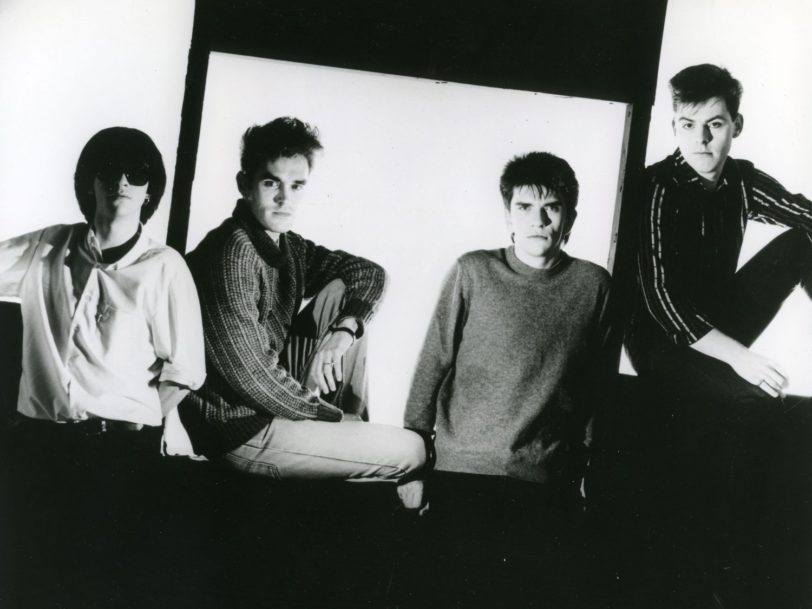Judging it by its UK chart peak of No.23, you might deem The Boy With The Thorn In His Side to be one of The Smiths’ lesser achievements. However, when placed in the wider context of the band’s legacy, it’s clear the song wasn’t just an artistic success, it provided one of the most pivotal moments in their career.
“The thorn is the music industry and all the people who never believe me”
The track dates back to The Smiths’ UK tour of spring 1985, undertaken in support of their Meat Is Murder album. Performed as an instrumental during soundchecks, The Boy With The Thorn In His Side really took shape after Morrissey added lyrics, and the band decamped to Manchester’s Drone Studios in August of that same year.
The scene of The Smiths’ earliest demo recordings in 1982, Drone was a relatively basic eight-track facility. Nevertheless, the band were fired up by The Boy With The Thorn In His Side and, while they’d only intended to lay the song down in demo form at Drone, they were so pleased with the results they were convinced the recording was good enough to be their next single.
The group were especially happy with the vibe because they felt that their previous few singles, among them How Soon Is Now? and Shakespeare’s Sister, had become increasingly densely layered. While there was no doubting the quality of those songs, The Smiths wanted to strip their sound back and rediscover what biographer Tony Fletcher felt was “the lightness of touch that had made previous singles such as William, It Was Really Nothing so instantly appealing”.
“With layers of shimmering guitars, you want it to go on forever”
Guitarist Johnny Marr was especially pleased with the fluid guitar arrangement he devised for the song. The result of using a Fender Stratocaster on record for the first time, Marr’s nimble playing even brokered comparisons with West African highlife music. Marr later acknowledged as much in an interview with The Guitar Magazine, but also revealed he’d drawn his inspiration from a completely different source.
“It ended up sounding quite highlife-y, yeah,” he said. “But if you listen to The Boy With The Thorn In His Side, the rhythm part from verse two onwards – that chick-a-chick part – it’s pure Nile Rodgers.”
Marr’s dexterity also brought out the best in bassist Andy Rourke and drummer Mike Joyce, who made the song swing with one of their most supple and assured rhythm tracks. Morrissey, too, was in heart-melting vocal form – but then the message behind his lyrics was entirely personal.
“The strangest thing in the world is when you get what you pray for”
The Smiths’ frontman revealed more about the song’s meaning when he was interviewed by Letter To Brezhnev actress Margi Clarke on an episode of Channel 4’s The Tube. Knowing Morrissey’s literary preferences, Clarke believed the song’s lyrics may well have been influenced by Oscar Wilde’s children’s story The Nightingale And The Rose, which included the lines “The thorn must pierce the heart, and your life-blood must flow into my veins and become mine”. Yet it turned out that Morrissey was on a completely different tack. He was writing about the fame he’d so enthusiastically courted – and how it affected him now he’d attained it.
“The thorn is the music industry and all these people who never believe anything that I said, tried to get rid of me and wouldn’t play the records,” he told Clarke. “So I think we’ve reached a stage where we feel… if they don’t believe me now, will they ever believe me? You know, what more can a poor boy do?
“I wanted [fame] for so long and now I’ve got it, isn’t that odd?” he added. “The strangest thing in the world is when you get what you really pray for.”
“You know it has to end sometime”
The Smiths allowed engineer and co-producer Stephen Street to upgrade The Boy With The Thorn In His Side to 24-track and add some discreet overdubs before they released it as their ninth UK single, on 16 September 1985. This session, held at London’s RAK Studios, proved especially productive as it also yielded two of the band’s finest B-sides, the dramatic Rubber Ring and the truly haunting piano ballad Asleep.
Committing The Boy With The Thorn In His Side and its attendant flipsides to tape gave The Smiths a huge jolt of confidence. With hindsight, it’s entirely fair to suggest that The Boy… wasn’t just a sublime pop song, it was the catalyst for the making of the record with which The Smiths are now most closely associated – the monumental The Queen Is Dead.
“The Queen Is Dead is quite a sombre, dark record, and its moments of sheer, Smiths-ian joy are slightly few and far between,” author and DJ Stuart Maconie reflected in an interview for The Smiths’ official YouTube channel.
“The Boy With The Thorn In His Side is the greatest of those moments. It has economy, it has passion, glamour and an extraordinary guitar arrangement by Johnny Marr, particularly towards the end, where it builds and builds, with those layers of coruscating, shimmering guitars. You so want it to go on forever, but you know it has to end sometime. It drifts away leaving you wanting a great deal more.”
Buy Smiths vinyl at the Dig! store.
More Like This
How Yes’ Self-Titled Debut Album Planted The Seeds Of Prog-Rock
With a sprinkling of psychedelia, jazz and classical influences, Yes’s debut LP offered bounteous hints of a prog-rock harvest yet to come.
‘Stand Up’: How Jethro Tull’s Second Album Broke The Blues-Rock Mold
Leaping beyond their bluesy beginnings, ‘Stand Up’ saw Jethro Tull pioneer a baroque fusion of ‘cocktail jazz’, English folk and hard rock.
Be the first to know
Stay up-to-date with the latest music news, new releases, special offers and other discounts!




